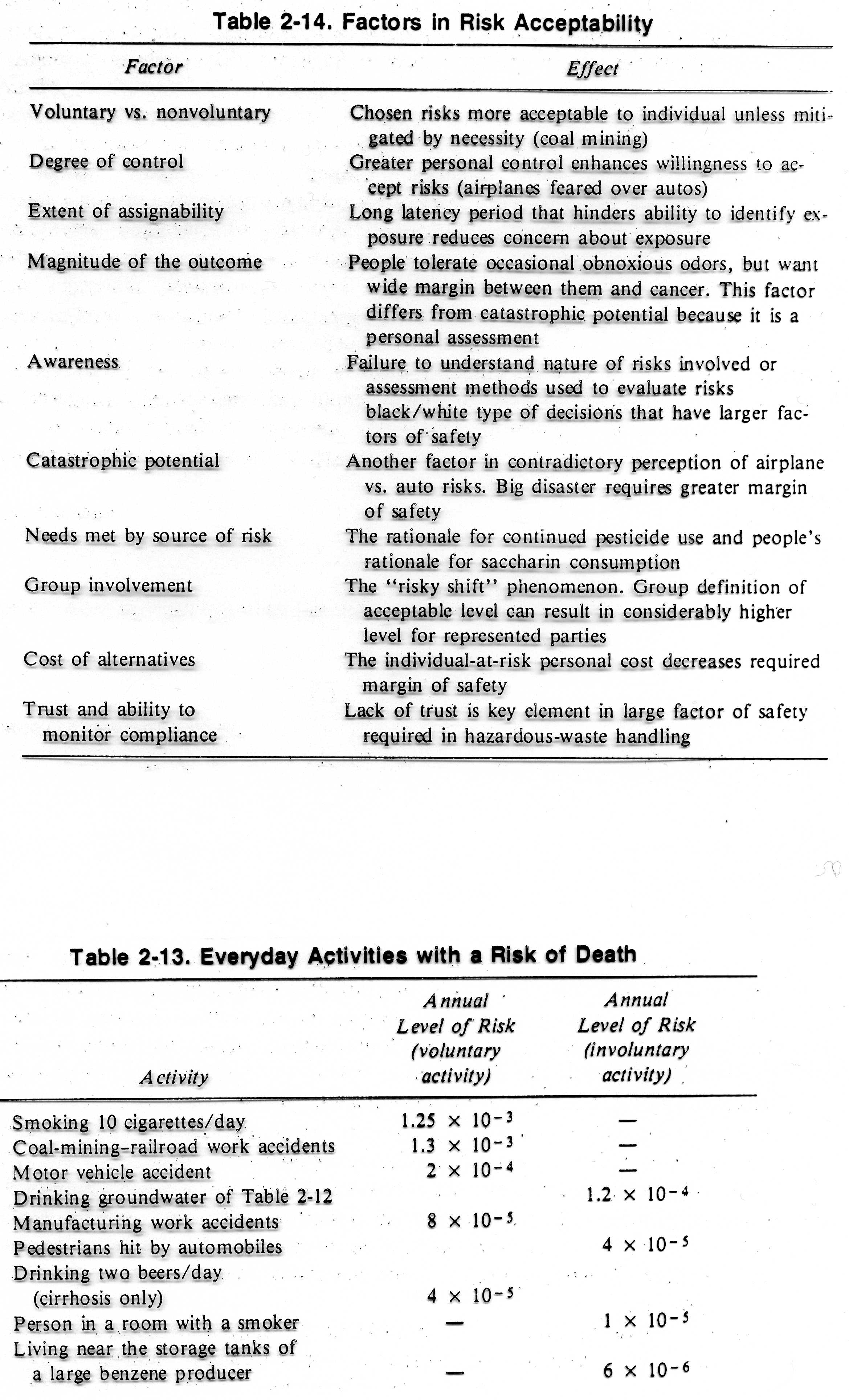Codzienne ryzyko

Table 2-14. Factors in Risk Acceptability
Factor Effect
Voluntary vs. nonvoluntary Degree of control Extent of assignability Magnitude of the outcome
Awareness
Catastrophic potential
Needs met by source of risk Group involvement
Cost of alternatives
Trust and ability to monitor compliance
Chosen risks morę acceptable to individual unless miti-gated by necessity (coal mining)
Greater personal control enhances willingness to ac-cept risks (airplanes feared over autos)
Long latency period that hinders ability to identify e.\-posure reduces concem about exposure People tolerate occasional obnoxious odors, but want wide margin between them and cancer. This factor differs from catastrophic potential because it is a personal assessment
Failure to understand naturę of risks involved or assessment methods used to evaluate risks black/white type of decisiohs that have larger factors of safety
Another factor in contradictory perception of airplane vs. auto risks. Big disaster requires greater margin of safety
The rationale for continued pesticide use and people’s rationale for saccharin consumption The “risky shift” phenomenon. Group definition of acceptable level can result in considerably higher level for represented parties The individual-at-risk personal cost decreases reąuired margin of safety
Lack of trust is key element in large factor of safety reąuired in hazardous-waste handling
Table 2-13. Everyday Activities with a Risk of Death
|
Actmty |
Annual Level of R isk (voluntary activity) |
Annual Level of Risk (involuntary activity) |
|
Smoking 10 cigarettes/day |
1.25 x 10-3 |
— |
|
Coal-mining-railroad work accidents |
1.3 x 10-3 |
— |
|
Motor vehicle accident |
2 x 10-4 |
— |
|
Drinking groundwater of Table 2-12 |
1.2 x 10~4 | |
|
Manufacturing work accidents |
8 x 10-5. | |
|
Pedestrians hit by automobiles |
4 x 10-5 | |
|
.Drinking two beers/day | ||
|
(cirrhosis only) |
4 x 10-5 | |
|
Person in ą.room with a smoker |
. — |
1 x 10-5 |
|
Living near .the storage tanks of a large benzene producer |
_ |
6 x 10-6 |
Wyszukiwarka
Podobne podstrony:
5Wsp Absorpcji metali THE UPTAKE OF HEAVY ELEMENTS BY HUMAŃ BEINGS TABLE 14.1 Absorption Factor (%)
img056 2 Wybrane aktywne przenośniki w metabolizmie: TABLE 14.2 Some activated carriers in metabolis
00110 j0536f1d3dde674795a26861d044a40 110 McWilliams Table 2 are madę. In the case of sampling by a
00152 ?cb17ca464b8901288e6dd4f0513e8d 153 Optimization and Sensitiyity Analysis Table 14. Cost Comp
kar1 1 7 ••• V w«/ 4 IV f ♦ • •14 li I»n»e # •rJ • » # » 0
Dz pobranie Hg,Cd TABLE 14.14 Intake and Absorption of Mercury from Air, Water and Food by Adults L
A Water table FIGURĘ 11.4 (A) In this natural system, the stream drains water from the region—not on
Ryzyko systemów informatycznych z perspektywy audytu. n Ryzyko audytu RA (ang. Audit Risk) Ra = Rw*R
First research works on LCA at Poznań University of Technology 95 Table 3. Materials used in the ope
20vcg25j Table Available Columns In TableManage lndexes -
Irish Lace Motifs: Lancelot Leaf 6C:h 14. Si *1 in serond rh fram honk. »c In ncxt 3 rh Mc In n
14 M. Piegza i in.INFLUENCE OF TR1CHODERMA STRAINS ON THE GROWTH OF PATHOGENIC MOULDS IN BIOTIC
DECORA25[2] 14 STUDY IN CLUSTERS By Gisela Maier SIZE: 23 1/2" in diameter. MATERIALS: Glossy c
więcej podobnych podstron